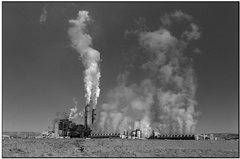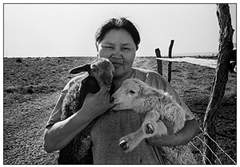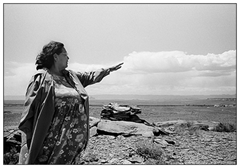Navajos Camp Out Against Coal
Air Date: Week of January 12, 2007

San Juan Power Plant, Four Corners, New Mexico. (Photo: © Carlan Tapp)
In the second installment of the series “Generating Controversy: The Changing Climate of Coal” reporter Eric Mack visits a Navajo reservation in New Mexico. The Navajo have lived with coalmines and coal plants for generations; now investors want to build a new plant on the reservation. The tribal council approved the plant proposal but some older Navajos are saying “no.”
Transcript
GELLERMAN: We now continue with our occasional series that we call “Generating Controversy: The Changing Climate of Coal.” The construction of new power plants that are fueled by coal is meeting stiff resistance in many parts of the United States. But perhaps nowhere is the clash as dramatic as on the Navajo reservation in New Mexico. The Northwestern part of the state already has two coal-fired power plants. And now, there are plans to build a third in the area. This one would be much cleaner than the others but a group of Navajo elders want to stop it before it gets off the drawing board.
Eric Mack reports.
MACK: Just south of Farmington, New Mexico, a road climbs to the top of a rocky hill covered with radio, TV, and cell towers. From up here, you can watch the sunset cast hues of pink and orange across the arid basin below. But a little to the north, those bright colors mix with a brown haze that hangs over Farmington and the Highway into the Navajo Reservation.
In the foreground I can see two big plumes of smoke and steam. They’re coming from the San Juan and Four Corners coal power plants. And with a quarter turn to the left I’m looking at the site of the new 1500-megawatt Desert Rock energy project.

San Juan Power Plant, Four Corners, New Mexico. (Photo: © Carlan Tapp)
[DRIVING AND DOOR OPENING]
MACK: Down below, along a rough road, is the entrance to the site, guarded by Navajo police. They've been here since December.
That's when a group of Navajo elders, local residents and their supporters blocked the entrance and set up a camp. Navajo police later moved the protesters’ camp to the other side of the road, and that’s where they’ve been camping ever since, through one of the coldest New Mexico winters in recent memory.
Elouise Brown is the president of Do’oda or “No” Desert Rock, a committee that opposes the new plant…
BROWN: We’re camping here and our reason is that we don’t want the, the third power plant here within a 25-mile radius and the reasons why we don’t want the power plant is because we want to be you know, keep our health, keep our land, keep our air fresh and we want to keep our water.
[CHOPPING WOOD]
MACK: In the last month, the camp has grown to a cluster of tee-pees and campers around a makeshift kitchen and fire circle. Today the grandchildren are pitching in to help cut up a load of firewood dropped off by volunteers.
Lucy Willie lives just a few miles from the site. And for the past month, she’s been spending most of her time here at the camp, holding vigil over the area, which she says is filled with sacred sites. She says coal has already taken enough of a toll here, and to illustrate the point, she motions across the empty grassland to a tall mound of coal waste or tailings.

Lucille Willie says, "The air is polluted, it is hard to breathe. The sheep have a hard time finding fresh plants to eat. It is not the right thing to do to restructure Mother Earth. “ The two lambs in Lucille’s arms died the following week.
(Photo: © Carlan Tapp)
MACK: You talking about this mine over here?
WILLIE: Yeah, the mine, I don’t think they’re going to put it like the way it is before. So I don’t want to have that down here, no. I mean it. I really mean it to stop.
MACK: Though many local elders oppose the plant, their government, the Navajo council, has approved it. The plant’s developers say it will bring 50 million dollars a year in property taxes, royalties and workers' paychecks.
Brown, Willie and other protesters say council delegates sold them out and now they’re hunkering down to make sure their voice is heard. And they’re getting help from activists throughout Indian Country and beyond - firewood, supplies and even an unlicensed, solar-powered radio station.
[STATION ID IN NAVAJO, YOUNG PERSON SPEAKING IN NAVAJO]
BOY: If you make the power plant there’s gonna be more global warming, so please do not make the power plant yet.
MACK: Navajos from other parts of the reservation are hearing about the camp and traveling to help, like Robin Jackson, who drove from Arizona to pose a question to the listeners of the upstart station.

Sarah Jane White looks out over the proposed 600 acre site for the location of the new Desert Rock coal burning power plant. (Photo: © Carlan Tapp)
MACK: Stephen Begay manages the Navajo Power Authority and that’s a question he thinks he can answer.
BEGAY: I think all of Navajo country is sacred land; it’s how we use the resources for the benefit of the good of the whole, you know, for the common. It’s a national effort. We have the Navajo Nation Council approval, 6 to 6, to 7.
MACK: And as for taking care of mother earth? Begay says that’s why they chose to team up with energy developer Sithe Global to build the plant. Dirk Straussfeld is the company’s Executive Vice President:
DIRK: They contacted us because of the environmental performance that we can bring with Desert Rock – low emissions and low water consumption with the lowest emission levels ever being proposed in the U.S.
MACK: It's true Desert Rock would probably be the cleanest conventional coal plant in the country, contributing less than 10% of the area's power plant pollution, despite it's size. Part of the reason this plant looks so good, is because its neighboring plants are so comparatively bad, blanketing the region in haze.
[SOUNDS OF THE CAMP]
MACK: But after so many past problems with coal and uranium, elders like Lucy Willie don’t trust industry claims.
WILLIE: I don’t believe it, not a bit of it. How could they do that? How could they make it like that? When you build the fire, it always come up with that smoke.
MACK: The elders have already weathered one big winter snowstorm so far and Willie says she can handle plenty more.
WILLIE: I can stay here all I want.
MACK: You’ll stay here as long as it takes?
WILLIE: Yeah, that’s what I already said in the beginning. I don’t care and I can stay here all winter until everything is straightened up until they stop and completely stop and then I can go back, otherwise, I’m gonna stay here.
MACK: For its part, Sithe Global Power hopes to break ground later this year and begin producing power in 2011.
For Living on Earth, I’m Eric Mack near Burnham, New Mexico.
Links
Desert Rock Blog (Opposing the proposed plant)
Navajo Nation (Supporting the proposed plant)
Dine C.A.R.E. (Dine Citizens Against Ruining our Environment)
Living on Earth wants to hear from you!
Living on Earth
62 Calef Highway, Suite 212
Lee, NH 03861
Telephone: 617-287-4121
E-mail: comments@loe.org
Newsletter [Click here]
Donate to Living on Earth!
Living on Earth is an independent media program and relies entirely on contributions from listeners and institutions supporting public service. Please donate now to preserve an independent environmental voice.
NewsletterLiving on Earth offers a weekly delivery of the show's rundown to your mailbox. Sign up for our newsletter today!
 Sailors For The Sea: Be the change you want to sea.
Sailors For The Sea: Be the change you want to sea.
 The Grantham Foundation for the Protection of the Environment: Committed to protecting and improving the health of the global environment.
The Grantham Foundation for the Protection of the Environment: Committed to protecting and improving the health of the global environment.
 Contribute to Living on Earth and receive, as our gift to you, an archival print of one of Mark Seth Lender's extraordinary wildlife photographs. Follow the link to see Mark's current collection of photographs.
Contribute to Living on Earth and receive, as our gift to you, an archival print of one of Mark Seth Lender's extraordinary wildlife photographs. Follow the link to see Mark's current collection of photographs.
 Buy a signed copy of Mark Seth Lender's book Smeagull the Seagull & support Living on Earth
Buy a signed copy of Mark Seth Lender's book Smeagull the Seagull & support Living on Earth

